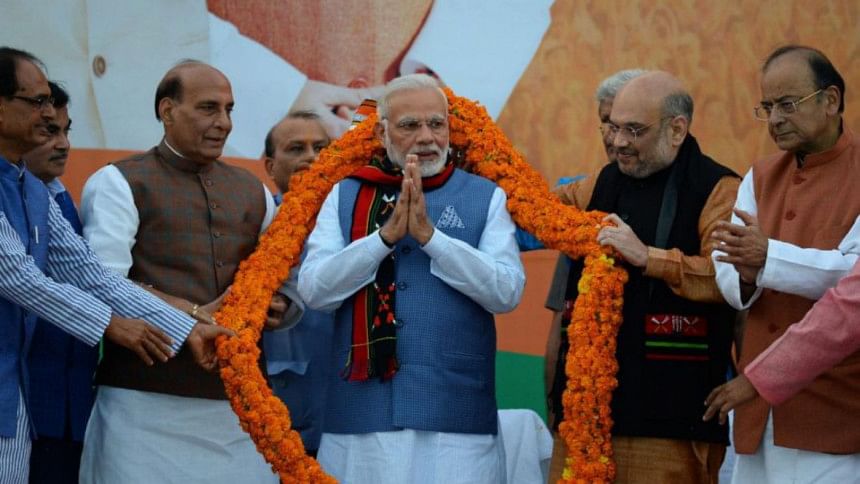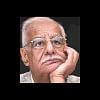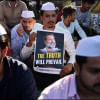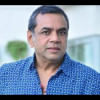It's Modi's BJP!

Prime Minister Narendra Modi is now all in all in the Bharatiya Janata Party (BJP). He has installed his close lieutenant Amit Shah as the party president. However, people's memory is short. The founder was Atal Bihari Vajpayee who subsequently occupied the office of Prime Minister to lead the NDA government, a coalition of several parties.
The miracle of Congress's demise took place under the leadership of Jayaprakash Narayan (JP), a Gandhian socialist. There was such a strong movement that all non-Congress parties came together on one platform. The old Jana Sangh members were very particular about maintaining their link with the RSS. This meant that the Hindutva ideology would remain to define the party's communal agenda.
JP's clothes of secularism did not fit the pro-Hindu Jan Sangh. Then the party was called the Jana Sangh. It was JP now admitted it into the opposition combination fighting the authoritarian rule of Prime Minister Indira Gandhi. JP was conscious that the Jana Sangh was a political arm of the RSS. But he had been given an undertaking that the two would part company.
When the Janata Party came into being, JP insisted on the Jana Sangh members, who occupied key positions in the Janata Party and government, to sever links with the RSS. JP knew how they had created an atmosphere where a Hindu would assassinate Mahatma Gandhi. Nathuram Godse touched Gandhi's feet and shot the Mahatma point blank. It became clear later that there was a well-prepared plan. The RSS was banned. The organisation's chief MS Golwalkar was arrested. But he was released after a year or so on the assurance that the RSS would not enter into electoral politics. It is another matter that they hid the fact that they are the guiding force. Today the organisation is selecting the BJP candidates for the state assembly. The Lok Sabha poll would see the same trend.
The undertaking on the RSS had turned out to be a ruse to join the Janata party. JP's reminders to Jana Sangh leaders to make good on the promise had no effect. How could they have when the Jana Sangh itself was an RSS creation, with the avowed aim of creating a Hindu Rashtra? Initially, the Jana Sangh members tried to explain to JP that the RSS wasn't what it was made out to be. When it came to the crunch, they refused point-blank to break ties with the RSS. JP felt cheated. But by then he was too sick to go back to the people to expose the Jana Sangh. He did make it public that his trust had been violated but he was helpless because of ill-health.
When the Janata Party raised the question of membership issue, the Jana Sangh members preferred to walk out. Curiously, by that time, they had acquired the credibility which the Jana Sangh, now the BJP, had not managed even after a few decades of Gandhi's assassination.
The two-year stay in the Janata Party and the portfolios they held in the central ministry helped the BJP immensely. On the one hand, for the party to saffronise the new members. On the other, they selected persons for assertive portfolios like information and broadcasting. Today the RSS seems to run on a daily basis.
The BJP also adopted at times a positive stance which confused the Hindu intelligentsia. When a leader like Atal Bihari Vajpayee was at the helm of affairs, he did a balancing act and rode two horses at the same time, Ayodhya-cum-Babri Masjid dispute and other factors percolated down to the BJP's winning 181 seats in 1998, against the usual single digit tally, in a 545-member house. After that, even JP's close followers found alibis to join hands with the BJP in the NDA so as to stay in the driving seat.
By then it was evident that the BJP was desperate to widen its base. Deputy Prime Minister LK Advani minimised the differences between the political BJP and the totalitarian RSS. He had done everything to "unify" the Hindus, the most dangerous was the Rath Yatra he led through northern India, dividing Hindus and Muslims who had lived together for centuries. Advani was so satisfied with the results drawing a clear line between the two countries that he equated the Rath Yatra to Ayodhya with Gandhi's Dandi Salt march.
Prime Minister Modi is implying all the time that he is bigger than the party. Even after four years of rule, it is not clear which direction he is taking the country. Granted that his diluted form of Hindutva is spreading in the country, but this process has stopped at the Vindhyas. The southern states do not seem to give the impression of full participants.
And once again the introduction of Hindi is creating the same problem as it did during the last days of Jawaharlal Nehru. Then his successor, Lal Bahadur Shastri, assured the nation on the floor of the house that the switch over to Hindi would solely depend on the non-Hindi speaking states who could say that they were ready for the switch over. It is up to Modi to see how he is able to reconcile with the two different trends. It is obvious that he would have to nudge the Hindi-speaking states. Only time will tell if he can do so.
Kuldip Nayar is an eminent Indian columnist.










Comments